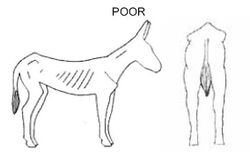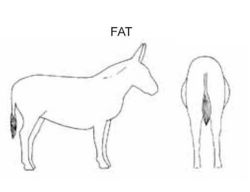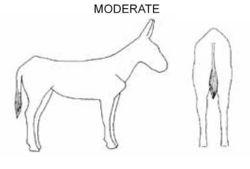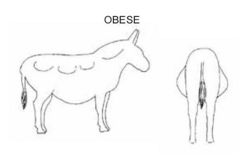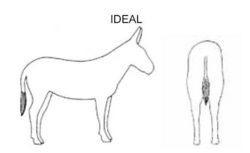Body Condition Score - Donkey
When feeding donkeys, it is important not to forget that animals are individuals and their responses to scientifically formulated rations are not entirely predictable. An active or more excitable donkey may need more food than a more sedentary or phlegmatic field-mate. To fine-tune diets to the donkey’s individual requirements, body condition scoring is a useful tool. Regular monitoring of body condition is also important and should be carried out monthly, particularly in early summer when there is abundant pasture and in winter when extra fat may be used to maintain body temperature.
The Donkey Sanctuary has developed a system which uses a five-point scale to assess body condition. Body condition score systems rely on the operator developing a practised eye and hand to detect small changes in the subcutaneous fat covering. It is also important for the operator to maintain objectivity when carrying out scoring to avoid the temptation to over- or under-score to get a more personally acceptable result. It may be better to ask a friend or member of the family to carry out the scoring if you are having trouble maintaining objectivity.
Donkeys and keepers should be calm and relaxed when body condition scoring. If the donkey is accustomed to being handled, it is more likely to cooperate. The condition scoring should be carried out in an area where there is plenty of light and plenty of space to move around the donkey. Initially, place the donkey in one of the three fat classes (thin, moderate or fat), then look for specific indicators for a more precise condition score. It is important to manually and visually determine the fat covering over the neck, shoulders, back, ribs, flanks and rump, taking into account the individual nature of the donkey. When you are a beginner at body condition scoring, try and get a second opinion from a more experienced person.
The tendency of horse owners to keep their horses in ‘show’ condition is also prevalent among donkey owners. A donkey in ‘show’ condition is likely to have a body condition score of at least 4. Further increases in body condition score for these animals may result in life-threatening obesity.
One of the main roles that body condition scoring can play is to provide an early indication of under-nourished or over-nourished donkeys. Once spotted, these small errors can be corrected by moderate changes in the diet. If they go unnoticed over long periods more drastic action may be required.
| CONDITION SCORE | NECK and SHOULDERS | WITHERS | RIBS and BELLY | BACK and LOINS | HINDQUARTERS |
| 1. POOR | Neck thin, all bones easily felt. Neck meets shoulder abruptly, shoulder bones felt easily, angular. | Dorsal spine of withers prominent and easily felt. | Ribs can be seen from a distance and felt with ease. Belly tucked up. | Backbone prominent, can feel dorsal and transverse processes easily. | Hip bones visible and felt easily (hock and pin bones). Little muscle cover. May be cavity under tail. |
| 2. MODERATE | Some muscle development overlying bones. Slight step where neck meets shoulders. | Some cover over dorsal withers, spinous processes felt but not prominent. | Ribs not visible but can be felt with ease. | Dorsal and transverse processes felt with light pressure. Poor muscle development either side of midline. | Poor muscle cover on hindquarters, hipbones felt with ease. |
| 3. IDEAL | Good muscle development, bones felt under light cover of muscle/fat. Neck flows smoothly into shoulder, which is rounded. | Good cover of muscle/fat over dorsal spinous processes, withers flow smoothly into back. | Ribs just covered by light layer of fat/muscle, ribs can be felt with light pressure. Belly firm with good muscle tone and flattish outline. | Cannot feel individual spinous or transverse processes. Muscle development either side of midline good. | Good muscle cover in hindquarters, hipbones rounded in appearance, can be felt with light pressure. |
| 4. FAT | Neck thick, crest hard, shoulders covered in even fat layer. | Withers broad, bones felt with firm pressure. | Ribs dorsally only felt with firm pressure, ventral ribs may be felt more easily. Belly overdeveloped. | Can only feel dorsal and transverse processes with firm pressure. Slight crease along midline. | Hindquarters rounded, bones felt only with firm pressure. Fat deposits evenly placed. |
| 5. OBESE | Neck thick, crest bulging with fat and may fall to one side. Shoulder rounded and bulging with fat. | Withers brad, unable to feel bones. | Large, often uneven fat deposits covering dorsal and possibly ventral aspect of ribs. Ribs not palpable. Belly pendulous in depth and width. | Back broad, unable to feel spinous or transverse processes. Deep crease along midline, bulging fat either side. | Cannot feel hipbones, fat may overhang either side of tail head, fat often uneven and bulging. |
References
- Svendsen, E.D., Duncan, J. and Hadrill, D. (2008) The Professional Handbook of the Donkey, 4th edition, Whittet Books
|
|
This page was sponsored and content provided by THE DONKEY SANCTUARY |
|---|
